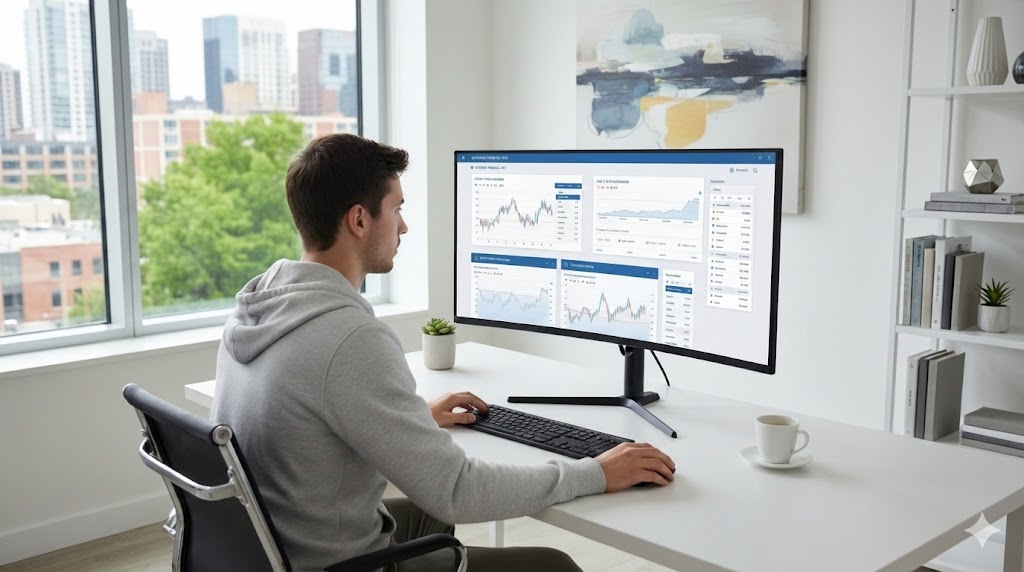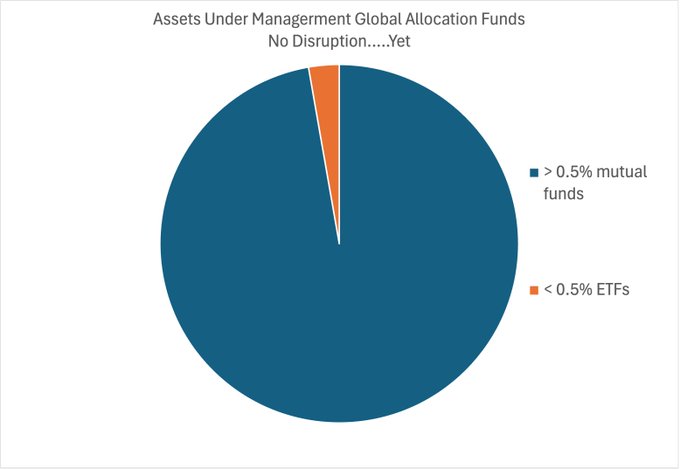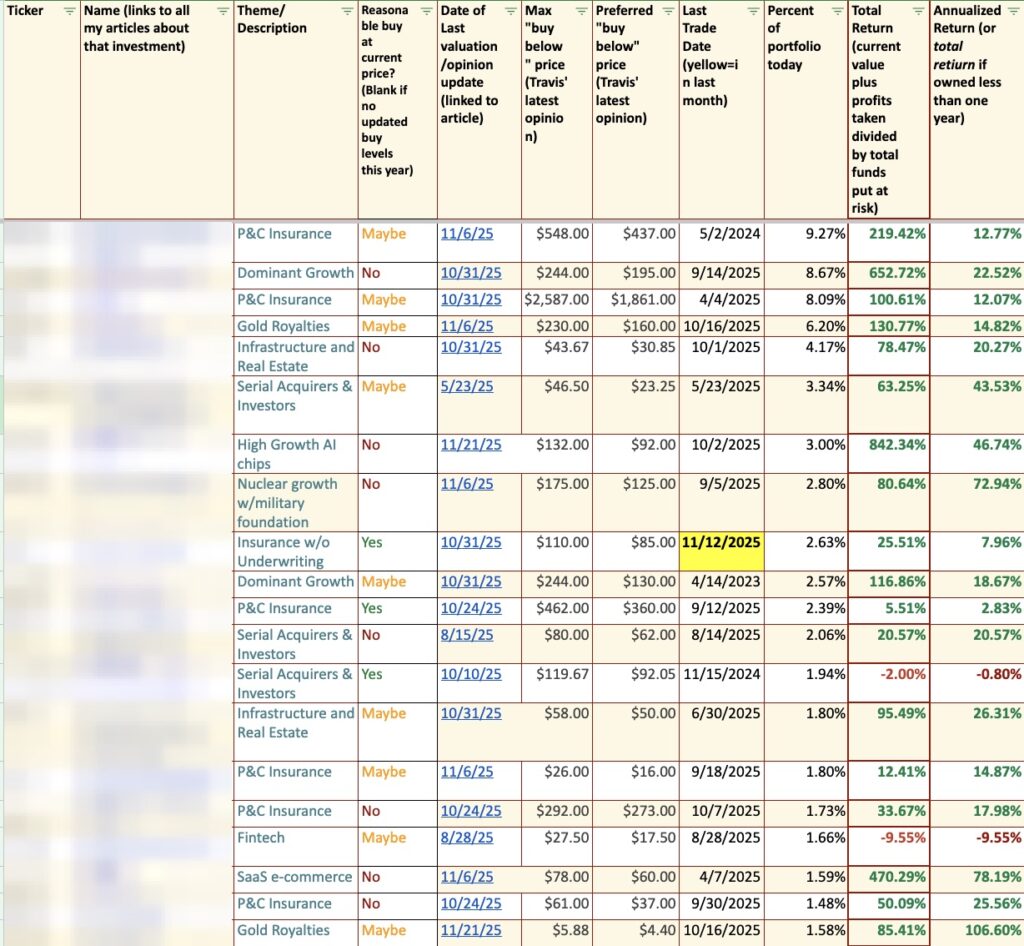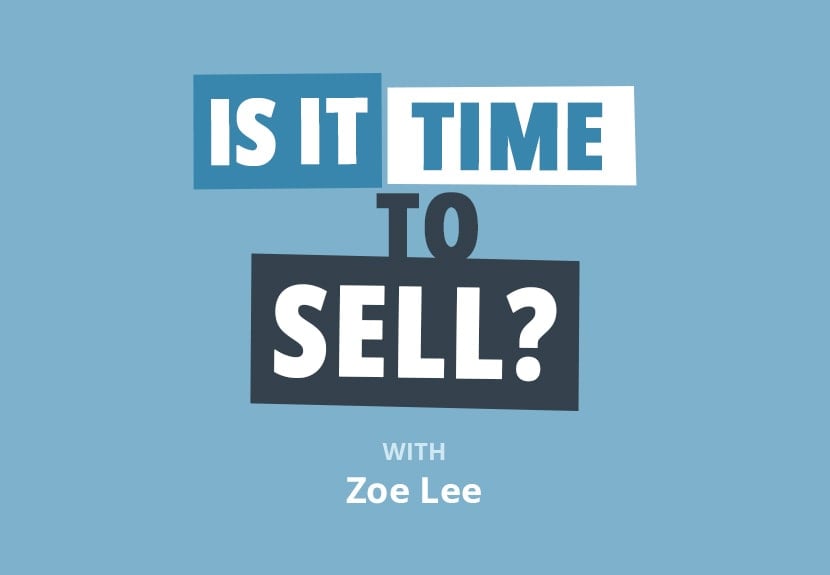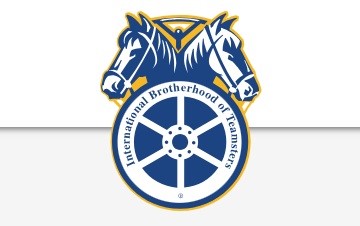Antony Velikagathu
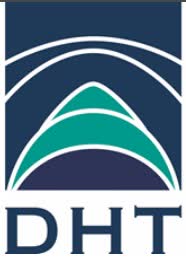
DHT logo (DHT website)
Investment thesis
The other day I had an appointment with my doctor and we got talking about life in general. She is interested in investing her money and is following my work here in SA. From reading some of my articles, she took an interest in DHT Holdings, Inc. (NYSE:DHT) after my buy stance in the article “Best House In A Bad Neighborhood” in February this year.
Fortunately, she told me that she was happy with the way it had turned out so far.
The Share price is up 85% since the middle of February this year.
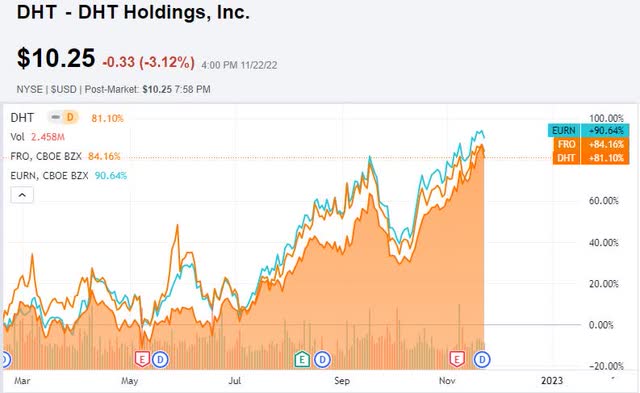
DHT share price since February 2022 , SA
After such a large increase in the share price, some might want to consider if they should jump ship. No pun intended.
Let us examine the latest financial results and what the prospects look like for DHT.
Third Quarter 2022 Financial Results
Management of DHT, like so many other managements, likes to refer to their EBITDA, which in the case of DHT was $35.6 million, but we prefer to look at net earnings or free cash flow from operation.
Their net profit in Q3 was $7.5 million which equates to an EPS of $0.04
The average time-charter equivalent earnings, or TCE, was $25,400 per day in Q3. That was an improvement of just $1,100 per day or 4.5% from the previous quarter.
Frontline (FRO) on the other hand had a much lower average TCE of only $16,400 per day for their VLCCs in Q2 and they are reporting Q3 on the 30th of November. It should show a much larger increase as they had communicated that they had covered 73% in August at $28,000 per day. On November 10th, in our last article on FRO, we put an estimate of an average TCE for their VLCCs at $30,000 per day. It might be too optimistic in view of DHT’s $25,400 per day as their average number. Time will tell.
In times of uncertainties around the world’s economy and rising interest rates, we look for companies with great balance sheets. DHT fits that description.
Over the last year, they have delivered to the point where their leverage is about 22.6% of the estimated market value of their fleet. The net debt per vessel is just $15.4 million at the end of Q3. That is below current scrap values.
DHT decided in September to change its dividend policy from paying out a minimum of 60% of its ordinary income to 100% of its net income to be returned to shareholders as quarterly dividends going forward.
The reason for this jump was based on the fact that leverage which used to be about 50% in 2015 has been brought down significantly since then and they have no Capex program going forward.
This new dividend policy was implemented in Q3 and as their EPS was $0.04 per share so will their dividend be.
We believe that the dividend will continue to rise throughout Q4 and the next year. The management wants to focus on dividends going forward instead of its past policy of paying a low dividend which yielded only 1 to 2% combined with their share buyback.
It is important to take into account share buybacks when we as investors consider how companies return capital to us. As for DHT, shareholders have in the past benefited from DHT’s active repurchases of shares.
During Q3 it bought back 1.5 million of its own shares for an aggregate sum of $8.8 million. All these shares have been canceled.
Business development
How markets will perform always comes down to the simple supply and demand balance – or lack of it.
As we often remind our readers, the supply side is fairly easy to predict since we know the status of the present fleet on the water and what is being built at shipyards to be delivered.
The present fleet of VLCCs in the world as of the end of October 2022 is 841 vessels.
Only 6 vessels have been sent for demolition over the first 10 months of this year. That is in stark contrast to the 36 vessels which was added to the fleet.
There are 11 more VLCCs scheduled for delivery this year and another 21 coming in 2023. We have no records of any VLCC new-building from 2024 onwards.
This number is quite manageable to absorb. We like to look at the number of vessels in a percentage of the fleet. Assuming we continue to see low attrition to the fleet, as a result of high rates, the increase is only 2.5%.
It is always much harder to predict demand.
Lots of news are readily available reporting a hot VLCC spot market of around $100,000 per day. To stoke more heat to this upbeat news, the good news is that this time the market has gone up mostly as a result of large shifts in the trading patterns.
And more is likely going to come. Some people might not be aware of it, but the EU has allowed Russian oil to flow to their countries, but only up to 5th of December 2022. Thereafter, it will be embargoed.
Russia is already switching to shipping its oil to Asia. These are much longer voyages. Europe which did receive much of the oil based on short distances is now taking it from further away like the U.S. and the Middle East.
Why has the crude oil price moved down lately?
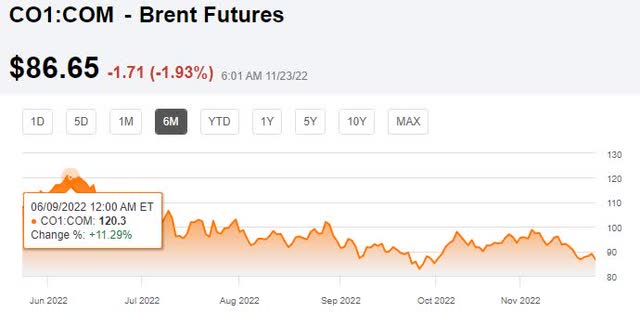
Brent Crude price is down 11% since June, SA
In June this year, it cost $120 per barrel. China has told shippers in Saudi Arabia to reduce the number of shipments. Their demand is not back to its pre-pandemic level yet. Their draconian way of handling the pandemic has pushed the economy and consumer sentiment to low levels.
There are signs of improvements, although the latest spikes in Covid-19 infections could potentially throw them back into the “lock them down” mode.
Or it could be another “song and dance” they are doing, just as they have tried with so many other commodities they hunger for. We will only get a clearer picture of this once the CNY festivities are over at the end of January 2023.
So to sum it up – the present market is very hot. It should be pretty good in 2023 too, but there are risks to the thesis in terms of potential demand destruction.
In light of this uncertainty, it was good to see DHT have continued to hedge its bet on the future.
During Q3 they fixed out “DHT Puma” or a substitute vessel for 5 years fixed time charter contract at $38,000 per day. They also gave the Charters an option to extend the charter for an additional two years at $41,000 for the first and $45,000 per day for the second.
The vessel is expected to deliver into the contract after the installation of an exhaust gas cleaning system in Q1 next year.
Conclusion
First, let me circle back to the beginning of this article with our investment thesis.
Even though we may add a disclosure statement that our articles are not meant to be financial advice and that readers should do their own due diligence and research before investing, when you sit face-to-face with someone that has relied upon your opinion, it brings an extra sense of responsibility on our shoulders.
Daniel Kahneman once wrote:
most people have a very high opinion of their own opinion”.
With that in mind, I shall try not to fall into that trap.
My personal opinion is that DHT will deliver a much better return and hence distribute considerably more than it did in 2022, provided we do not get demand destruction in crude oil.
As such, my buy stance continues.


